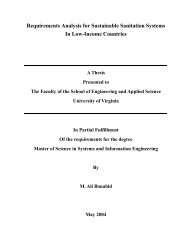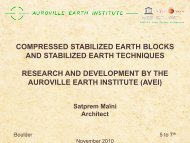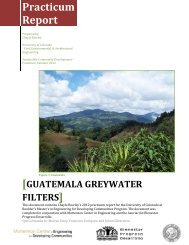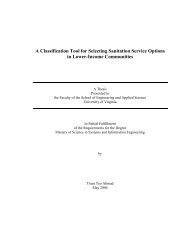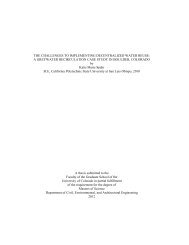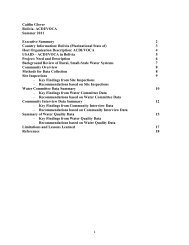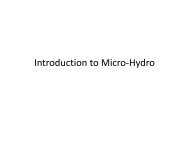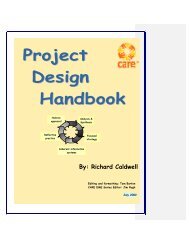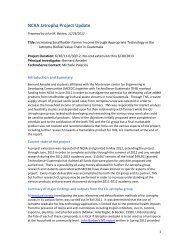SCEBs - University of Colorado Boulder
SCEBs - University of Colorado Boulder
SCEBs - University of Colorado Boulder
You also want an ePaper? Increase the reach of your titles
YUMPU automatically turns print PDFs into web optimized ePapers that Google loves.
Lower Limit: 1 part cement, 1 part water, 20 parts clay, 20 parts sand<br />
Dead Man‟s Curve (Samples 01 & 02):<br />
Upper Limit: 1 part cement, 1 parts water, 10 parts clay, 10 parts sand<br />
Lower Limit: 1 part cement, 1 part water, 20 parts clay, 20 parts sand<br />
These ratios assume that the clay used is highly disturbed and moist. Additional<br />
water may need to be added if the clay is dry, as compared to the water contents listed in<br />
Table 4.3. If the cement to be used is relatively loose, rather than densely packed into a<br />
bag (i.e. as purchased at a local hardware store), it is imperative that the cement content<br />
be either doubled or tripled from the ratios recommended above. As always, organic<br />
material, such as roots, should be removed prior to the manufacturing <strong>of</strong> <strong>SCEBs</strong>.<br />
4.2. Ute Mountain Ute Tribe<br />
4.2.1. Introduction<br />
The purpose <strong>of</strong> the tests was to evaluate the suitability and durability <strong>of</strong> the soil<br />
materials in question for use in stabilized compressed earthen block (SCEB) production.<br />
The New Mexico Earthen Building Materials Code and ASTM Codes were followed as<br />
closely as possible when applicable. The results from wet sieve analysis, Atterberg limit<br />
tests, and Hydrometer tests were used to determine the USCS soil classification for each<br />
soil sample. Model-sized blocks were made using each soil sample and tested in<br />
compression to determine their unconfined compressive strength (UCS). The durability<br />
behavior <strong>of</strong> the model-sized blocks was assessed by testing under uniaxial compression<br />
blocks subjected to a series <strong>of</strong> saturation/drying cycles. Full-scale SCEB blocks were<br />
produced and tested to determine their physical, deformability, and strength properties.<br />
Portland cement was used to stabilize all blocks. The addition <strong>of</strong> cement was intended to<br />
41



